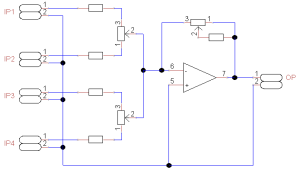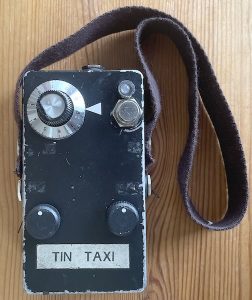In another article I described three different solutions to a battery powered mixer. This is sort of similar, but describes a different approach.
The usual approach (as in all the mixers described in the other article) is to have a gain control on each input then a master gain control. Now when setting the balance between two vocalists, or a vocalist and a guitar, then adjustments of a few dB can make quite a difference to the mix. But the gain control typically has a pot which can set the gain over a range of 50dB or more, so setting a small difference is a chore.
The approach here is to have a mix control, one simple knob which can be used to set the balance between two inputs. Then there is another knob for the overall gain.

Click on image for a detailed description and schematic.

I decided to try it out by re-wiring a mixer I made some years ago. It is primarily for busking but can also be used for recording. It does not use an op amp as in Fig 1. Instead it uses a simple discrete transistor amp based on Rod Elliots simple mic amp. I have modified it to work from a 9V PP3 battery and it takes only around 1.6mA and is quite low noise.
All of the potentiometers were already installed in the box so I decided to keep them, even though reducing the values would be better from a noise point of view. In practice the output noise will be dominated by background noise from the microphone.
I added capacitors to each input to curtail the low frequency response. I did not want inaudible low frequencies driving the amp close to saturation.
Conclusions
The mixer is best used as a mixer when required, or as a preamp if recording on the iphone. It will imporove the noise floor on the MacBook, but this will not make a noticable difference for a youtube recording.
So if recording onto the Macbook with only one mic (my usual style) I may as well just use the cable. If I need 2-4 mics, then use the mixer.
If recording into the iPhone, use the mixer.
Busking or performing, (with the busking amp) use the mixer.
Works for me